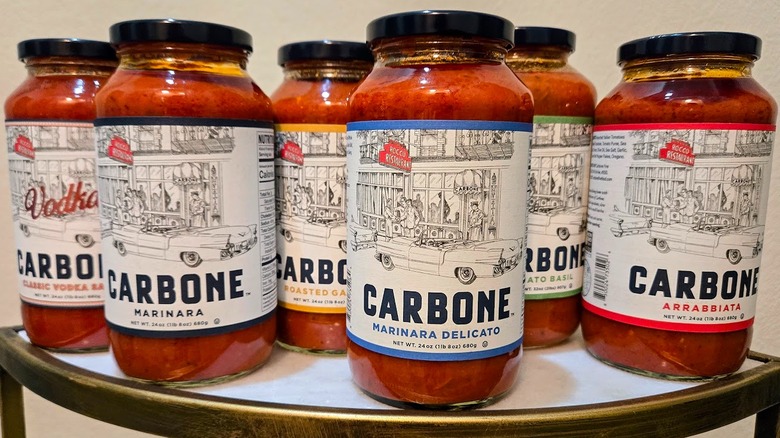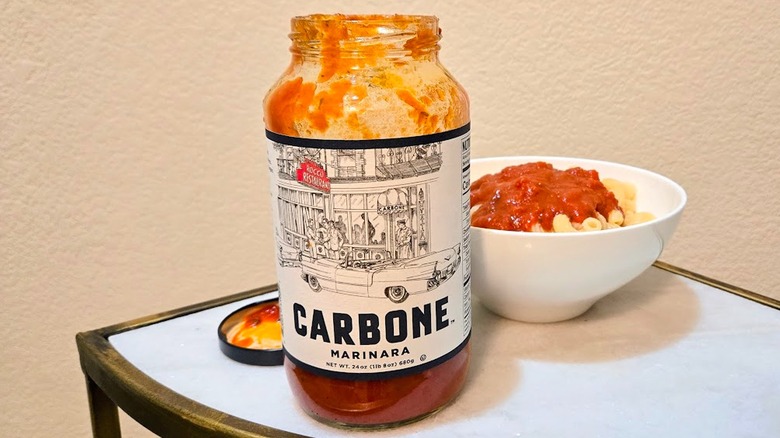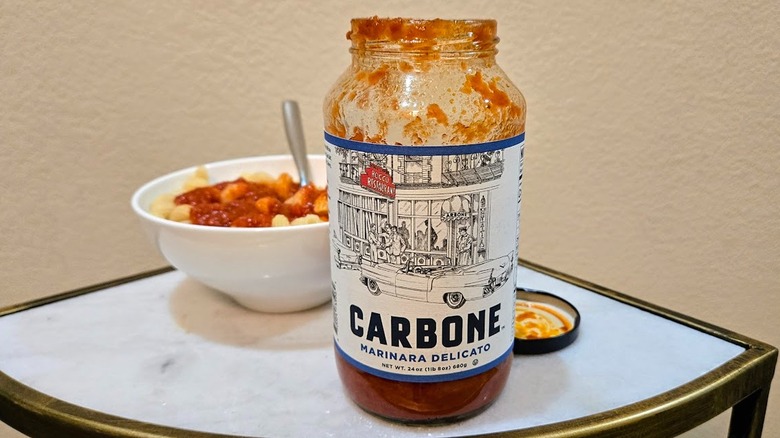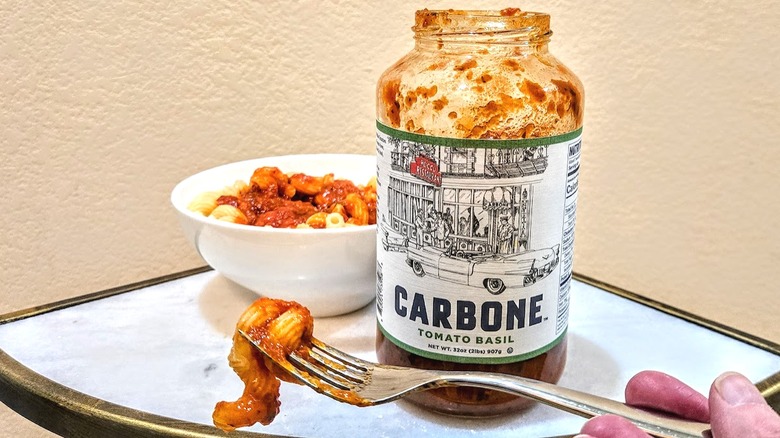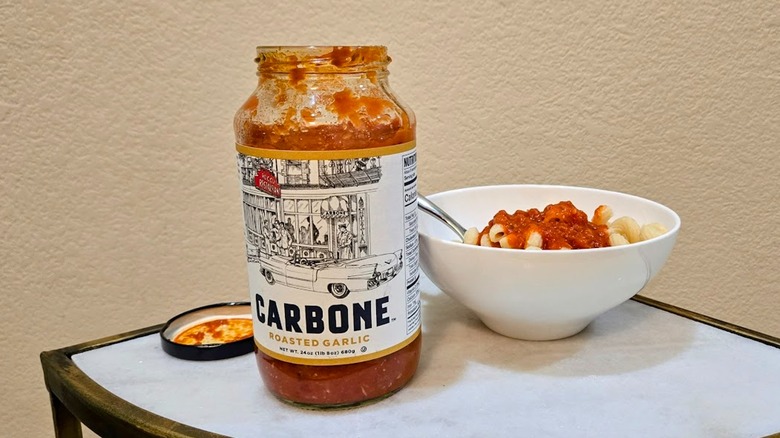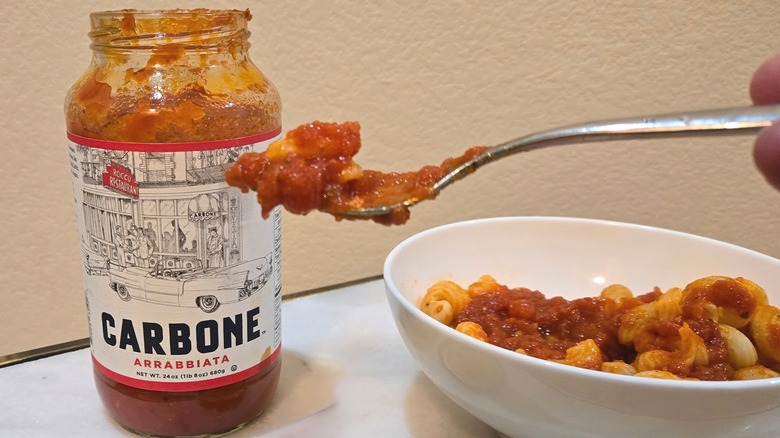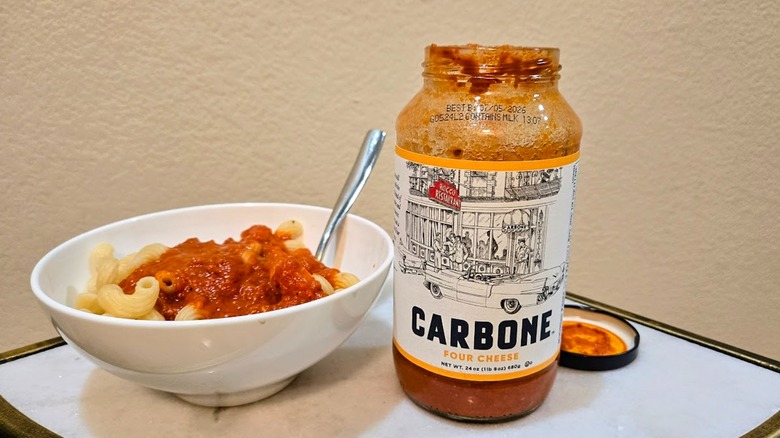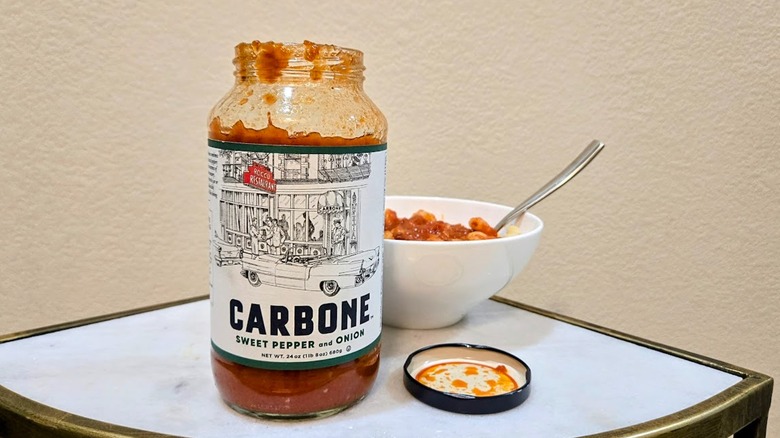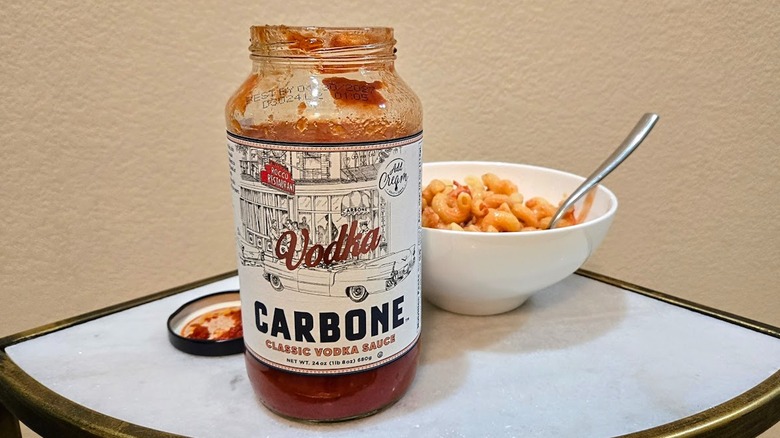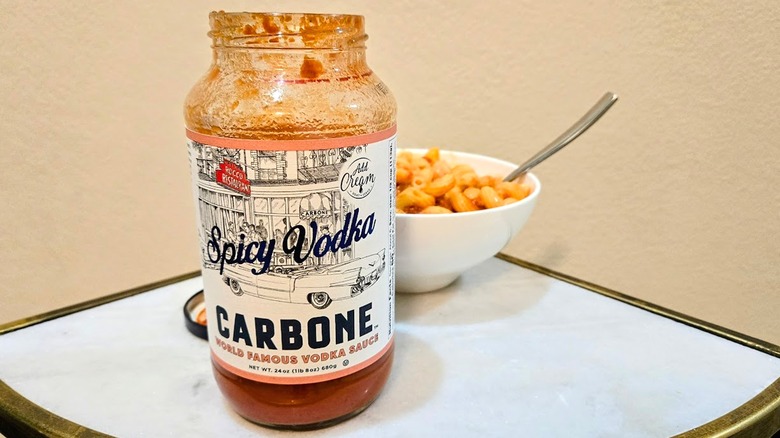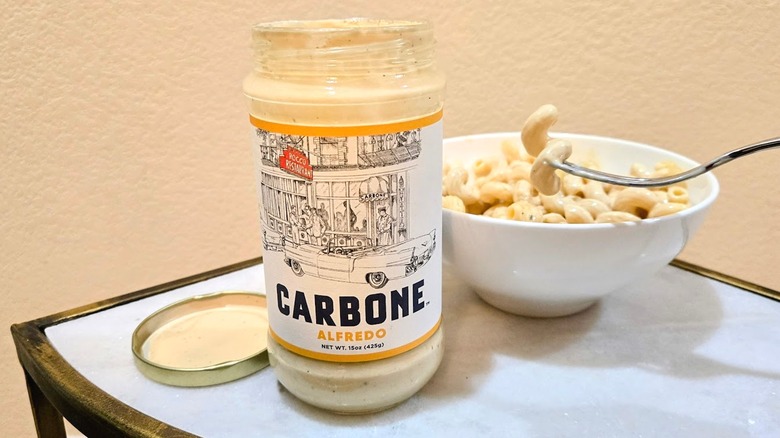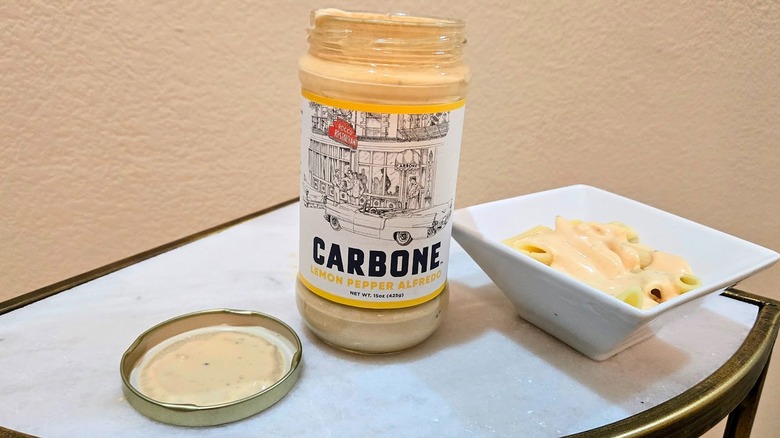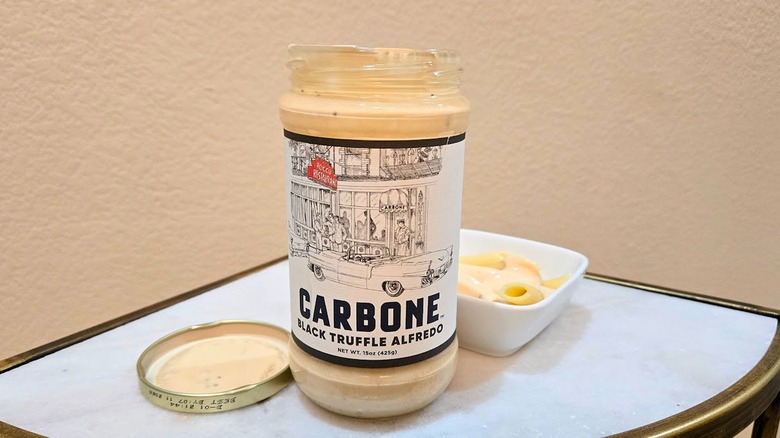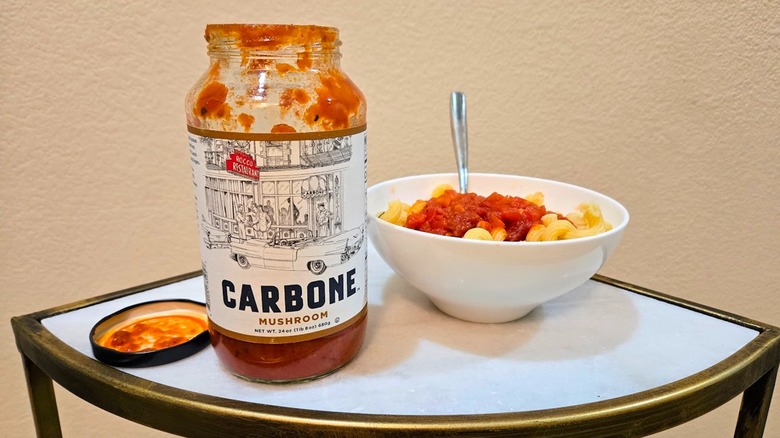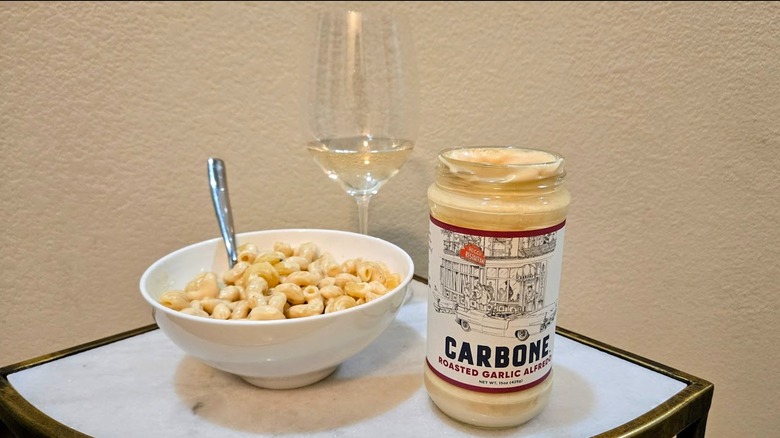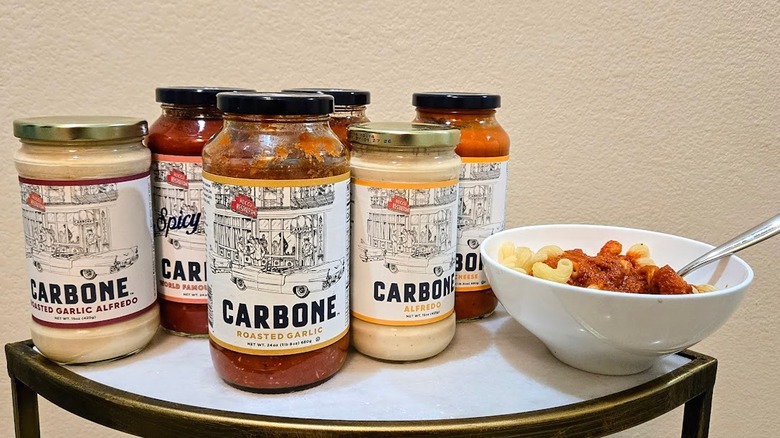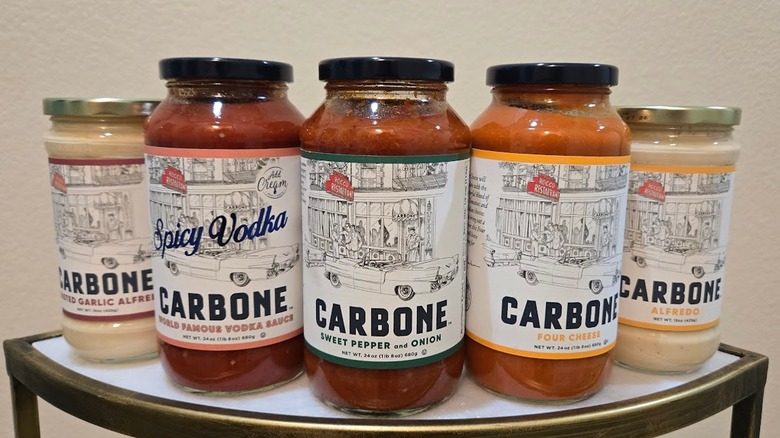Review: Are Carbone's Pasta Sauces Worth Buying?
We may receive a commission on purchases made from links.
One of the most comforting dishes for a Sunday family feast is a bowl of spaghetti with a perfect red sauce. However, making homemade sauce requires hours in the kitchen. Thankfully, dozens of marinara sauce line store shelves offering a homemade taste in a jar. One option gains its inspiration from New York City's Carbone Restaurant.
Carbone is the brainchild of Queens-raised chef Mario Carbone and his partners at Major Food Group, chef Rich Torrisi and entrepreneur Jeff Zalaznick. The New York Italian-American restaurant has since become a celebrity hot spot known for classic dishes with a sprinkle of old-school nostalgia, like veal marsala, lasagna bianco, and rigatoni with spicy vodka sauce to the likes of Jennifer Lopez, Kendal Jenner, Rhianna, and the Biebers on any given night. The restaurant, which opened in 2013, quickly earned a Michelin star. Though it has since lost its star, it has continued to see success, opening locations in Dallas, Miami, Las Vegas, and Hong Kong.
Jars of Carbone's marinara sauces from Carbone Fine Foods became available in small production batches on the East Coast in 2021. Since then, the brand has added additional red sauces, Alfredo options, and pizza sauces priced around $10 a jar, all certified as made with Project non-GMO ingredients. These options became available while expanding distribution nationwide.
Today, Carbone sauces are available in many major grocery stores as well as via Amazon. With such an expansive group of options available, we want to know if the sauces are worth your investment. While they are less expensive than a bowl of pasta at Carbone's restaurant, spending $10 for a jar of sauce is pricey. To decide, I visited my local grocery stores and Amazon delivery, purchasing 11 of the brand's top pasta sauce options and taste-testing each one. Here are my thoughts.
Some recommendations are based on firsthand impressions of promotional materials and products provided by the manufacturer.
Carbone Marinara
Carbone prides itself on crafting sauces made from fresh ingredients instead of dried or dehydrated herbs and tomato paste. Its sauces are slow-cooked in small batches, simmering for an hour to capture the homemade taste. The Carbone Marinara Sauce was a part of the initial sauce offerings from the brand and, like all of the sauces, includes hand-picked Italian tomatoes grown in mineral-rich, volcanic soils. The soil is similar to the volcanic soils in San Marzano sul Sarno in the Campania region of Italy that help the famed San Marzano tomatoes achieve their delightful sweetness and intense, authentic tomato flavor. Additional ingredients include onions, garlic, olive oil, salt, basil, and oregano. The sauce has 90 calories per ½-cup serving, with 7 grams of fat and 5 grams of sugar.
My initial reaction to this bright, ruby red sauce was the freshness in the marinara's flavor. That bright, clean tomato flavor carried through from the initial tasting out of the jar and on a bowl of hot pasta. The accompanying ingredients balance the natural tomato sweetness with the proper amount of salt to season the sauce without overwhelming to deliver a fresh tomato-rich palate. The marinara's well-balanced flavor has versatility. It can sauce your next bowl of spaghetti and meatballs, act as the sauce for your pizza, or provide a dip for pan-fried ravioli.
Carbone Marinara Delicato
Carbone Marinara Delicato is for you if you have an aversion to garlic and onion. The sauce is similar to the original marinara, beginning with whole Italian tomatoes and tomato puree. Then, instead of adding the alliums, Carbone adds celery and carrots, olive oil, salt, and Italian herbs, including basil and oregano. The sauce has a slightly higher calorie and fat count than the original marinara, with 100 calories per ½-cup serving, 10 grams of fat, 5 grams of sugar, and 1 gram of protein.
As the name indicates, the kosher sauce has a much more delicate flavor. However, I found myself missing the garlic and onions. The sauce was chunkier than the classic option, with a slightly more oily sheen that gave it an underlying oily taste when trying it on its own without pasta. When I added it to the hot cavatappi pasta, the sweetness of the sauce dominated, leading me to want to add black pepper, cheese, or hot chili flakes to balance the overall taste. If allium plants trigger an allergy, the Delicato sauce is a good option. Otherwise, stick to the classic marinara to top your next bowl of penne or linguini.
Carbone Tomato Basil
Carbone Tomato Basil pasta sauce includes the same non-GMO ingredients as its original marinara sauce, with similar calorie, fat, and sodium amounts. However, the tastes could not be further apart. Where the marinara sauce has a clean, fresh tomato and herb flavor, the tomato basil shows the richness that cooking a ragù for a long time brings. I would never guess this sauce simmered for only an hour as it has slow-cooked complexity.
The differences between the two sauces are evident from the outset, as the color of the tomato basil has a deep caramelized tomato hue compared to the bright red of the marinara. The sauce has a much chunkier texture than some others, which I didn't prefer as the ingredients did not seem uniform or well-emulsified. Upon opening the jar, I noticed a good amount of oil on the top that did not fully come together once thoroughly stirred.
Tasting the sauce on its own, the herbaceous character of the basil came through, though it was more of a sweet note of cooked basil rather than the peppery, spiciness of fresh, raw basil. The herbal notes meld nicely with the sweetness of stewed tomatoes and aromatics with proper seasoning from the salt. I appreciate the slow-cooked taste of the Tomato Basil sauce as it was different from any of the others I tried, making it a nice addition to the portfolio. However, if a fresher flavor is your preference, skip this option.
Carbone Roasted Garlic
Opening the jar of Carbone Roasted Garlic Sauce I was immediately hit with an aromatic garlic scent that would ward off a visit from Dracula. However, tasting the sauce on its own and over a hot bowl of pasta revealed a sweet caramelized garlic taste. The sauce consists of many of the same non-GMO ingredients found in Carbone's other sauces, including whole peeled Italian tomatoes, onions, basil, oregano, salt, and olive oil, with the addition of roasted garlic that has been cooked in olive oil.
The cooking method gives the sauce a luscious, concentrated, slow-roasted, well-balanced flavor with a hint of sweetness. Though the glistening sheen of the sauce led me to believe that there was likely a high amount of oil in the product, the vegan, gluten-free sauce was smooth and well-emulsified without having an oily taste. For true garlic lovers, try dipping garlic and herb breadsticks in this sauce for an over-the-top garlic experience.
Carbone Arrabbiata
The flavor of a genuine Roman-style spicy penne arrabbiata makes my heart jump. The sauce, meaning angry in Italian, is from Italy's Lazio region and traditionally features a simple ingredient that gives arrabbiata its iconic heat: red pepper flakes. These pepper flakes simmer in olive oil, garlic, and tomatoes to create a fiery sauce that envelopes an al dente pasta for a bold punch of Italian flavor.
Unfortunately, Carbone Arrabbiata Sauce misses the mark. The ingredients list resembles a classic arrabbiata sauce, with imported Italian tomatoes, garlic, onions, red pepper flakes, olive oil, salt, and herbs. However, in the arrabbiata sauce, more so than in any others, there is an overabundance of oil, making Carbone's sauce a greasy mess. Surprisingly, it provides similar calories, fat, sugar, and sodium as the other sauces. However, no amount of shaking or stirring could bring the ingredients together. Instead, a thick layer of orange oil remained separated on top of the sauce.
The actual flavor of the sauce was unexpectedly mild when considering the name's translation. There was subtle heat on the back palate, but I had to search for it. It did not deliver the fire expected from an angry sauce. If you are a fan of a traditional peppery arrabbiata with ample heat, I would skip this sauce.
Carbone Four Cheese
Carbone's Four Cheese sauce includes a mix of Parmesan, Asiago, Romano, and ricotta. The cheese blends with the same whole peeled Italian tomatoes as the other sauces with garlic, heavy cream, and black pepper. Carbone Four Cheese sauce has more calories than the brand's other red sauces, with 110 calories per ½-cup serving. Still the added calories come from additional protein in the sauce instead of fat or carbohydrates. The four cheese sauce has 4 grams of protein compared to only 1 in the other red sauces, with the same 7 grams of fat.
Tasting the sauce on its own and over pasta revealed an enjoyable cheesy tomato flavor. However, the sauce's texture was not as pleasant. It was very grainy and poorly emulsified, indicating the various cheese varieties were not fully integrated into the sauce. The sauce's appearance showed this as well, lacking the glossy sheen of the other Carbone sauces. Flavorwise, the salt in the sauce was nicely incorporated, providing appropriate seasoning without dominating, which was impressive considering the number of salty cheese varieties included. The sauce didn't set itself apart from other four or five cheese pasta sauces on the market. Add the sauce's expensive price, and this is one to skip from the brand.
Carbone Sweet Pepper and Onions
Slow-simmering tomatoes, sweet bell peppers, and savory onions to create a luscious sauce ideal for spooning over anything from pasta to steak or sausages to seafood sounds delicious. The natural sweetness of each ingredient becomes amplified during the slow cooking process. And, while the idea of sausage with bell pepper pasta sounds delicious, or using pepper and onion sauce as an option for meatballs instead of marinara, I suggest skipping Carbone's Sweet Pepper and Onion sauce to make it. This one didn't wow me like some of the other options did from start to finish.
Though the sauce includes ripe red and yellow bell peppers with onion, garlic, olive oil, salt, rosemary, and tomatoes, the dominant flavor is the Italian tomatoes. The roasted sweetness of slow-cooking and caramelizing onions and peppers was lacking in the finished sauce, and there was only a mild hint of a woody, herbal note the addition of the rosemary should add. While the sauce's pepper note was underwhelming, the consistency was pleasantly chunky and well-emulsified, creating unity throughout the sauce and providing a textured mouthfeel.
Carbone Classic Vodka
If you are looking for a simple, healthy red sauce without the fuss, out of the jar, Carbone Classic Vodka Sauce is just that as the brand jars this sauce, which traditionally contains cream and butter, without either. Instead, the producer recommends that the home cook add these ingredients themselves. Carbone includes the recommended amounts of fats on its labels to take the guesswork out. Out of the jar, the vodka sauce has 50 calories per ½ cup and only 1.5 grams of fat. However, the sodium and sugar amounts are higher than in the other sauces, with 6 grams of sugar and 750 milligrams of sodium, almost double the sodium in the other sauces.
The taste straight out of the jar is fresh but relatively neutral, even though garlic, onions, vodka, sea salt, olive oil, and black pepper are included in the sauce, along with Italian tomatoes. While vodka is an essential ingredient in vodka sauce, the alcohol is not detectable. Instead, adding vodka to a tomato sauce helps enhance the flavors of the other ingredients, concentrating the flavors.
The sauce's magic comes when mixing in the butter and cream, which Carbone recommends is 8 ounces of cream, 2 tablespoons of butter, one pound of pasta and the whole jar of vodka sauce. The resulting pasta is sufficiently saucy, with a balance of acidity from the tomatoes and richness from the cream and butter. Comparing Carbone's classic vodka sauce to the spicy vodka, I would likely pick up a jar of the spicy vodka sauce as it has a bit more complexity and punch of flavor. However, if you like a layer of creaminess in your pasta without the heat hot peppers can bring, this sauce is for you.
Carbone Spicy Vodka
Pasta with spicy vodka is a dish that has gone viral after supermodel Gigi Hadid posted about it on Instagram in 2020, and Carbone's $34 spicy rigatoni pasta dish on its New York restaurant menu has garnered dozens of copycat versions across the internet. Thankfully, the restaurant opted to add the spicy vodka sauce from their famous dish to a jar, so all you have to do is add it with butter and cream to your favorite type of pasta for the much more reasonable price of around $10 per jar. You can even get this jar of Carbone sauce delivered with a home delivery service straight to your door.
If you are a fan of vodka sauce with a kick, this is the sauce you will want to try as it includes the vibrant ingredient to spice up your sauce. The sauce contains Calabrian chili paste as the spicy element, melding with Italian tomatoes, garlic, onions, olive oil, salt, and vodka. The heat of a Calabrian chili is intense, with a medium heat level hitting between 25,000-40,000 heat units on the Scoville scale. The heat is nowhere near as fierce as that of a habanero but quite a bit more than the mild heat of a jalapeño.
Once you add the sauce with this fiery chili paste to butter and cream, it becomes a full-flavored, well-rounded sauce with spicy, rich, savory complexity with just the right amount of acid from the tomatoes cut through the heavy cream's richness to keep the flavor bright and balanced. Though Carbone suggests how much fat to add to its sauce, the ultimate decision is yours, allowing you to make it as creamy and decadent as you like or keep it light to showcase the intense spiciness of the Calabrian chilis. Either way, this sauce is tasty.
Carbone Alfredo
Fans of a mouth-coating, ultra-rich, creamy, buttery sauce will enjoy Carbone's Classic Alfredo. It delivers what is expected from a creamy, cheesy white sauce in its purest form. While the Carbone red sauces are available in a standard 24-ounce or 32-ounce jar, Carbone's Alfredo standard size jar is only 15 ounces.
While it is a smaller jar, you won't need as much sauce for your pasta as it is decadent, layered with Romano and Parmesan cheese, cream, butter, and egg yolks creating an Alfredo with double the fat and calories of its red sauces. Where Carbone's red sauces contain all natural ingredients, its Alfredo sauces also include stabilizers like disodium phosphate, corn starch, and xanthan gum. While I prefer an all-natural sauce, the additional ingredients ensure the sauce maintains a thick, creamy consistency.
As far as the overall flavor, after tasting it straight and mixed with cavatappi pasta, I found it to be thick, unctuous, and balanced. My preference leans towards spicy, peppery flavors, so this is one I would skip in the future. However, the buttery, creamy sauce has all the elements any classic Alfredo sauce lover would enjoy.
Mediterranean Marinara
Fans of puttanesca sauce will love Carbone's Mediterranean Marinara. The sauce is essentially a vegan version of the popular Neapolitan sauce. Puttanesca became popular in the Italian city in the mid-20th century, following World War II. The original recipe includes a mix of tomatoes, capers, olives, and anchovies — perfect for dressing pasta in a shrimp puttanesca.
Carbone foregoes the anchovies in its version, melding Italian tomatoes with capers, black olives, garlic, onions, herbs, and olive oil instead. Carbone's sauce has similar nutrition facts as the brand's other red sauces, with 90 calories and 7 grams of fat per serving. It also comes in 24-ounce jars.
The best part of this chunky marinara is its briny character and rich viscosity, which coats the pasta noodles with silky olive oil, tangy, sweet tomatoes, zesty capers, and earthy, savory olive flavors. The sauce has salinity, as you would expect from the ingredients, so be careful not to over-salt your pasta cooking water. Even with the salty taste, the natural creaminess of the olives and the sweetness of the tomatoes combine with the capers to create inviting, mouth-watering flavors that you will want to spoon over grilled swordfish, fresh pasta, or shrimp and chorizo skewers.
Lemon Pepper Alfredo
I like a good amount of pepper in Alfredo to help cut through the richness of the creamy sauce. Thankfully, Carbone delivers all the pepper I need with its Lemon Pepper Alfredo sauce. The sauce perfectly combines the zesty brightness of sun-kissed citrus, the spiciness of freshly ground black pepper, and the rich creaminess of an Alfredo sauce. Like the other Carbone Alfredos, the fat and calories are high — 100 calories and 9 grams of fat per ¼ cup.
However, even with the fatty, creamy richness of the light cream and butter, this sauce had a lighter mouthfeel thanks to the inclusion of lemon juice and lemon peel, which added freshness and acidity. Black pepper and white pepper add punchy sharpness and earthiness, melding with the sharp flavors of Parmesan and Romano cheese. Though I tasted it simply on its own over pasta to evaluate, I also prepared the sauce with sauteed shrimp, peppery arugula, and penne pasta for my family. After tasting the dish, my husband promptly said, "We are adding this dish to our weekly dinners!"
Black Truffle Alfredo
Fans of black truffle will immediately delight in Carbone's Black Truffle Alfredo. When I opened the 15-ounce jar, I immediately smelled earthy, forest-floor aromas of truffle and mushroom, making my mouth water with truffle-filled anticipation. Carbone melds light cream and butter with sharp Parmesan and Romano cheese and aromatic, earthy black truffle to create a creamy and unctuous sauce — speckled with black truffle flakes and just a hint of pepperiness to round out its flavor.
Carbone does not specify what type of truffle goes into its black truffle sauce, so I don't know whether it is domestically grown or from Europe or if it is a summer or winter black truffle. Either way, its flavor is robust and wonderfully earthy, making it a delicious sauce for truffle cream pasta. The fat and calories are high, similar to the brand's other Alfredo sauces, with 110 calories and 10 grams of fat in each ¼-cup serving. However, that fat translates to flavor, which this luxurious, silky sauce successfully delivers.
Mushroom
The beauty of a well-made mushroom marinara is that it has the meatiness of a typical beef ragù, all while still fitting the confines of a vegetarian diet. Carbone's Mushroom Marinara tackles this directive head-on, delivering a rich, well-rounded, and savory red sauce. The brand uses cremini mushrooms in its sauce. Though cremini mushrooms are not as earthy or reminiscent of the forest floor as some wild mushroom varieties, like morels or chanterelles, the cremini gave a subtle, woodsy, nutty character to the sauce. The non-GMO sauce has similar nutrition facts to Carbone's other red sauces. There are 90 calories and 7 grams of fat in each ½-cup serving, and it's available in 24-ounce jars.
While some mushroom marinara sauces feature finely diced mushrooms, which makes it hard to tell if the fungi are even in the sauce, Carbone's sauce was laden with mushroom slices. These slices mingle with crushed, ripe Italian tomatoes, lending both sweetness and acidity. The onions, garlic, basil, oregano, salt, and olive oil create a uniformly textured sauce with a savory and umami flavors. Enjoy the sauce over a piping hot bowl of pasta with a glass of your favorite Willamette Valley or Bourgogne pinot noir wine to further enhance the earthy, forest-floor notes of the mushrooms.
Mac and Cheese Alfredo
It is easy to understand why Carbone added Mac and Cheese Alfredo to its line of sauces. A bowl of creamy, cheesy, warm mac and cheese is one of the most comforting meals. The best mac and cheese starts with a rich béchamel base, blended with a mix of creamy, sharp, and salty cheeses.
Carbone's sauce delivers the creaminess I expected. However, it lacked the cheesiness. Though the sauce includes white cheddar cheese with light cream and butter, the sharp saltiness was missing. Though rich, it was somewhat flat, especially when compared to some of the brand's other red and Alfredo sauces that have a big flavor. The 15-ounce jar of Mac and Cheese Alfredo reminded me more of the brand's classic Alfredo than mac and cheese. However, the classic Alfredo has a sharper flavor, thanks to the inclusion of Parmesan and Romano cheese. I still needed freshly ground pepper to elevate the taste of its regular Alfredo, as I did with this sauce.
Like the other Alfredo sauces, Carbone adds additives to thicken it, like xanthan gum and modified corn starch, which I prefer to avoid in my diet. The fat and calories are also high; there are 100 calories and 10 grams of fat per ¼-cup serving. Plus, Carbone's other Alfredo sauces bring bold, unique, and more balanced flavors. Unfortunately, this one did not deliver the authentic mac and cheese taste I was hoping for, making it one you can skip.
Carbone Roasted Garlic Alfredo
Many sauce brands jazz up its traditional Alfredo sauces with additional ingredients, like pesto, sun-dried tomatoes, mushrooms, or roasted garlic. The additions bring complexity and interest to the taste of the classic sauce. Carbone spices up its jarred Alfredo sauce with roasted garlic, enhancing the flavor of the classic. The essential ingredients for the sauce begin the same as in Carbone's Alfredo, with garlic contributing less than 2% in the finished sauce. The roasted garlic Alfredo also delivers two times the amount of fat and calories of Carbone's red sauces, with 100 calories per ¼-cup serving and 9 grams of fat.
The overall garlic taste isn't as much at the forefront as in Carbone's roasted garlic tomato sauce since the sauce's butter, cheese, and cream contribute to the dominant flavors in the Alfredo. However, the garlic that does come through, while subtle, brings a rich, slow-roasted flavor. I suggest using it in this crock pot chicken Alfredo recipe as it has just the right hint of caramelized garlic taste to enhance the slow-cooked dish.
Are Carbone's Sauces Worth It?
As a whole, Carbone's pasta sauces are delicious. They bring slow-cooked, homemade flavor. The sauces are suitable for keto lifestyles and are made with non-GMO ingredients. These ingredients include imported tomatoes that showcase the Italian terroir from which they are grown.
While the brand is about four times more expensive than many other commercial sauces, like a widely available jar of Prego or Ragu, the robust, small-batch, slow-cooked flavor Carbone delivers across the portfolio makes it one to add to your grocery basket next time you are at the supermarket. There are a few options I would skip, as noted. However, as a whole, Carbone delivers red sauces for classic Italian American dishes with authenticity and creamy, thick Alfredo with richness.
Methodology
To decide if Carbone's $10-a-jar sauces are worth dropping a Hamilton on, I collected an assortment of options available locally in my city or online via Amazon. From there, I conducted a taste test, first by trying each sauce on its own without pasta. Then, I warmed a few spoonfuls of each and added it to hot bowls of cavatappi pasta. In doing this, I was able to evaluate if the flavor had changed, improved, or worsened once pasta was introduced.
Additionally, I researched the production of each sauce, particularly noting that each uses premium, non-GMO ingredients while also offering options that are gluten-free, kosher, and vegan. As a long-time home cook and certified sommelier who has spent a career reviewing wines, spirits, and foods, I taste-tested and reviewed each, determining if you should add a jar to your shopping cart on your next trip to the grocery store.
